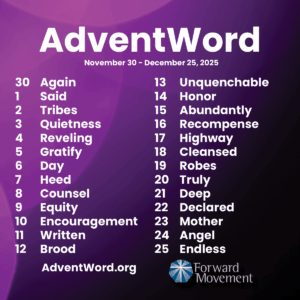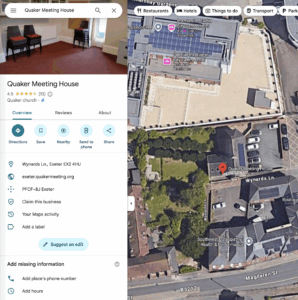 This is part of the Quaker Alphabet Project click here for more information.
This is part of the Quaker Alphabet Project click here for more information.
E is for Equality and Environment
Environment
Here I’m not thinking of our green and pleasant land, but around the Meeting House inside and out.
According to Quaker Faith & Practice – Elders have a responsibility to ensure ‘the right holding of MfW’ and ‘to be responsible for the quiet gathering of the meeting for worship in order, reverence and harmony, for the arrangement of seating‘.
Whilst Premises have the responsibility to ensure that the meeting isn’t doing that gathering whilst balancing gingerly on unsafe chairs or dodging leaks.
However it is a joint effort to ensure that the building and its surroundings looks as the Meeting would like it to look, as with any place clutter and unorganised areas can start to build up without anyone having the responsibility to sort, purge and clear them away.
- Have you ever asked yourself or others in the Meeting how the Meeting House should look? Looked as a prospective visitor or hirer may?
- What does that quote mention of ‘order, reverence and harmony’ let alone the seating look like for your Meeting House?
- Does the Meeting House meet the needs of all of the various types of user groups and still maintain a sense of peace?
- Are there ways you could address any problem areas and create a more harmonious and serene space to worship and work in?
Equality
Recently one of the most interesting (and frustrating) aspects of managing a Meeting House has been around Equality. Both in relation to Disability Access and trying to balance all the needs/wants of each group with different ages and practical requirements, in a building which was built well before such concerns was common place is not uniquely Quaker – many other churches and historic buildings struggle with such things.
There are various rights around access and equality that are legislated about. More details on those can be found at the Government’s ‘Creating a Fairer and More Equal Society‘ pages. But to quote one very frustrated disabled Quaker,
“I just wish people would remember that disabled doesn’t mean wheelchair user!”
Ramps, lifts, evacuation concerns and hearing loops may all require professional advice. As well as a disability advisor or architect who can be questioned on specific instances or concerns that you might have about your building. I’m not going to attempt to offer any advice on such things.
But here are a few other tips I found useful that are simple and cheap to implement.
1) Ensure all door frames and doors are a different colour to the surrounding walls. This gives someone with partial visual impairment a large rectangle to aim at.
2) Have a variety of different types of chairs, some with arms, some without, some taller and some shorter. If at all possible allow people to choose their own chairs, with cushions available for those who need them (one meeting has a basket of fleece rugs too as several of their elderly Friends were feeling the cold), and perhaps footstools. Consider where else you can supply such things – for example left handed scissors and can openers were donated at a previous meeting I attended by a left handed Quaker.
3) Offer different lighting options – a task light by the library desk where people want to read/write for example or under kitchen cupboards where people are preparing refreshments.
4) Supply photographs of drawer or cupboard contents as well as labels. As it was pointed out you shouldn’t presume that people can read your (often small) labels, or can read English…
It also meant the cupboards and drawers were tidied out thoroughly before we took, printed and laminated the photos. These are used and commented upon by people who can read and see perfectly well but find the photos easier.
- What steps have you taken to ensure that your building is suitable for all?
- Did you find professional advice useful?
- Have you produced any leaflets or guidance to improve access or equality among members and attenders?
To browse through all of the posts click on the Quaker A-Z link here or in the side bar.






